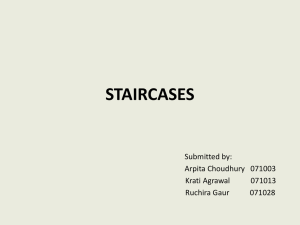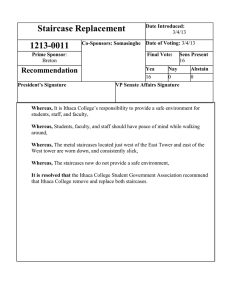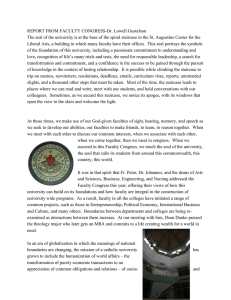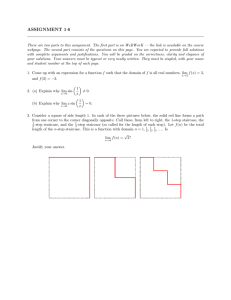Curved Staircase Planning Guide
advertisement
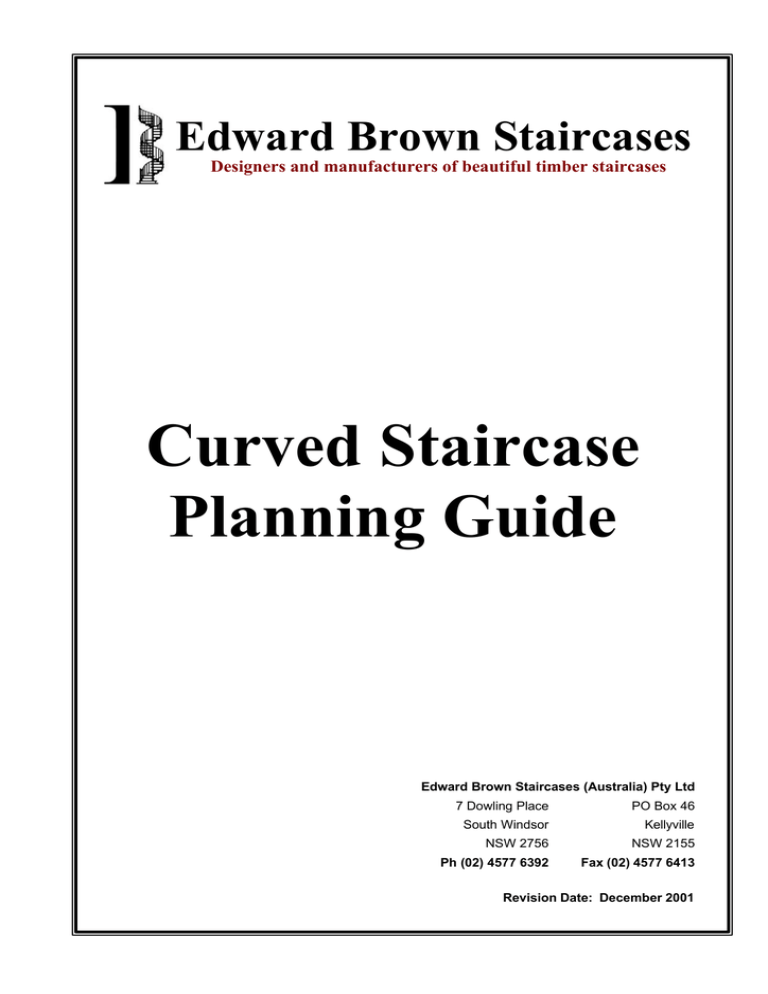
Edward Brown Staircases Designers and manufacturers of beautiful timber staircases Curved Staircase Planning Guide Edward Brown Staircases (Australia) Pty Ltd 7 Dowling Place PO Box 46 South Windsor Kellyville NSW 2756 NSW 2155 Ph (02) 4577 6392 Fax (02) 4577 6413 Revision Date: December 2001 Edward Brown Staircases Introduction The purpose of this illustrated staircase planner is to assist you to plan and customise a staircase to suit your own individual requirements using as many stock elements as possible to achieve a well proportioned, gracious staircase that is safe and comfortable to use. We recommend that the stock elements shown in this guide be used as much as possible. This ensures that the final staircase not only has a look of quality and craftsmanship but also does so at a reasonable cost. We are always happy to design and build custom staircases when requested but the work involved in making special formworks, patterns etc. increases the cost substantially. How to use this Planning Guide This guide shows each of the stock elements necessary to plan and customise your staircase. We recommend that you use the following steps: • Take the Measurements • Select a Stair Plan • Choose a Style Each of these steps is illustrated in the sections below. We have also provided a comprehensive set of stair plans with layouts and sizes in Appendix A. These stair plans will enable you to accurately determine the exact area you will need to fit your desired staircase. The sizes given are what we regard as a minimum. Extra space may be gained by reducing the tread width but we do not recommend this as the stairs may become cramped and dangerous. While you are using this planning guide keep the following points in mind to ensure you achieve a costeffective result. • Use stock components; • Keep stair turns to a minimum (¼ or ½ turn); • Use a handrail on only one side of the stair. Take the Measurements The first step is to make an accurate sketch, not necessarily to scale but correctly dimensioned. The sketch should show: • Location of the stairs; • Height from the starting to arrival points; • Amount of headroom under the start of the stairs; • Size of the well hole 1 Use a level to check the height from starting to arrival points • Length of the run or runs; • Depth of the storey joists and the floor; • Position and height of surrounding doors and windows; • Whether the stair is to be self-supporting and lined underneath or will a cupboard go underneath. Any other relevant points that you think may apply should also be noted on the sketch. Note: Please be aware of the points illustrated below when making your sketch. 2 3 Check walls for plum A = 120 cm ( 3 ) B = 160 cm ( 4 ) C = 200 cm ( 5 ) Check angles for square 4 Check walls with a straight edge Staircase Planning Guide Copyright - December 2001 Page 2 Edward Brown Staircases Select a Plan The second step is to take the sketch you have made and, using the dimensions shown, decide on the stair plan that best fits those dimensions. The stair plans below show a few of the stairs most commonly used by our customers. They include the following types of staircases: • The 300 Series stairs that save space; • The popular 600 Series; • The sweeping 1500 Series; • The S Series spiral stairs. A complete illustrated list of our stair plans is contained in Appendix A - Illustrated List of Staircase Plans, attached to this guide. Note: To avoid confusion all staircases illustrated are right handed - we manufacture to either right or left hand at no extra cost. Staircase Planning Guide Copyright - December 2001 Page 3 Edward Brown Staircases Choose a Style Handrails and Balusters The type of handrail and baluster you select will influence the style of your staircase. There are three main styles that are used. These are: • Colonial (Georgian) style; • Modern (Contemporary) style; • Blended (somewhere in between) style. Colonial Style If you want a colonial style then choose the H-1 pattern handrail and a C1, C2, or C3 baluster. C6 or C7 balusters are used on closed string stairs only. Modern Style For a modern look a choice of the H-2 handrail and baluster B8, B9, B10, or B11 should be made. Blended Style If a less defined style is desired the H-2 handrail and baluster B4 or B5 should be used. The diagrams below show the balusters and handrails that we have as stock items. Handrails Balusters Staircase Planning Guide Copyright - December 2001 Page 4 Edward Brown Staircases Return End Brackets There are six different return end brackets that are stock items. These are shown below. Colonial Style For a colonial style choose any of the return end brackets. Numbers 5 and 6 being the most ornate are an excellent choice. Modern Style Since modern style staircases are usually closed string they do not use return end brackets. Blended Style For a style somewhere in between choose a plain bracket such as No’s 3 and 4. Our return end brackets have been designed to give a pleasing look without being too ornate. In our experience more elaborate brackets do not suit the narrow ended treads of curved geometrical staircases. Return End Brackets Stair Startings There are five different stair startings to use that are stock items. These are shown on the page following. To achieve the style you want use the suggested stair starting indicated below. Colonial Style For a colonial style staircase choose any of the cut string stair startings from No’s 1-4. Modern Style For a modern look the closed string starting shown in No. 5 is the one to use. Blended Style For a less defined style the starting will depend on the type of string, cut or closed, you intend to use. Staircase Planning Guide It is often necessary to start or finish a staircase from some fixed point such as a doorway opening. Treads (steps) may be added or subtracted to the bottom and top of the staircase to allow for such adjustments. With landing types such as Stair No 125-3 an allowance of 250mm should be made per tread to the stairwell measurements indicated on plans, either adding or subtracting as necessary. Geometrical winding staircases (stairs without landings or platforms) are also easily adjusted to suit your requirements by shortening or lengthening the bottom and top stair runs. Copyright - December 2001 It is essential that the total run of the top and bottom when added together remain the same as dimensions on the layout plan. Example: Stair No 300-2 Bottom flight added to top flight has a 2.461m+2.641m = 5.102m total run around the wall. The same procedure is used with stairs with curved wall strings. The measurements being taken square into the corner. If it is decided to increase the stair height by say one riser 250mm must be added to the total run. This is essential to ensure that the tread widths remain correct on the walking line for the 1000mm staircases illustrated in the plans in Appendix A. Page 5 Edward Brown Staircases Stair Startings Staircase Planning Guide Copyright - December 2001 Page 6 Edward Brown Staircases Balustrading The diagrams below show the three types of balustrading commonly used. The first is the cut string balustrading used in Colonial Style staircases. This uses a solid timber facia and nosing to give an elegant finish to the stairs The second is the closed string balustrading used in modern style staircases. A solid timber fascia is used without a nosing that gives a clean and smooth appearance. The third is the cut string with no fascia where a plasterboard wall is used. This can be used for a blended effect or where a cupboard will be built under the stairs. Balustrading Details Cut String Staircase Planning Guide Closed String Copyright - December 2001 Cut String No Fascia Page 7 Edward Brown Staircases Appendix A - Illustrated List of Staircase Plans 125 Series Staircases The 125 series staircases require the minimum amount of space and are very economical because of their small radius turns. Small radius turns used in conjunction with landings give a flowing and continuous line of handrail with no unsightly angles or crippled turns. Staircase Planning Guide Copyright - December 2001 Page 8 Edward Brown Staircases Staircase Planning Guide Copyright - December 2001 Page 9 Edward Brown Staircases 300 Series Staircases The 300 series staircases with winding treads on turns are great space savers. If wreathed strings and handrails are used they assume an elegance of their own. The 300-1 half turn staircase takes up only slightly more space than a spiral staircase but gives more comfort and a better appearance. Staircase Planning Guide Copyright - December 2001 Page 10 Edward Brown Staircases 450 Series Staircases The 450 series staircases take a little more room than the 300 series but give a more gentle transition from the straight to the curved portion of the handrails and strings. Broadening out the start of the staircase to increase the width of the starting tread will give the staircase an added dimension of space. Staircase Planning Guide Copyright - December 2001 Page 11 Edward Brown Staircases 600 Series Staircases The 600 series staircases are our most popular. These stairs blend in well with most of today’s more spacious homes and do not take a great deal of floor space. The 600 series staircase looks gracious and comfortable in its setting. Staircase Planning Guide The 600-1 plan shown below is a double-sided version with the left side terminating into the wall. This increases the feeling of size and spaciousness in the foyer. Copyright - December 2001 Page 12 Edward Brown Staircases Staircase Planning Guide Copyright - December 2001 Page 13 Edward Brown Staircases 900 Series Staircases The 900 series staircases require more space but are a worthwhile investment where the floor area is available. These stairs use larger balusters that are spaced so that there is one baluster for each winding tread. Staircase Planning Guide The 900-1 shown below is broadened out and splayed at the bottom to a 2400mm radius which gives it a feeling continuity and openness which can be fully appreciated when viewed from the gallery above, Copyright - December 2001 or looking up from the entry. Page 14 Edward Brown Staircases 1500 Series Staircases The 1500 series sweeping staircases give a true feeling of the “Grand Entrance”. Square internal corners are not practical with this type of stair, as the winding treads would be very wide in the internal angles. If the “Gone with the Wind” style of stair is what you are looking for the 1500 series staircase will be your choice. These stairs give a feeling of elegance and grace that will be a source of pride for many years. S Series Spiral Staircases The S series spiral staircases are an ideal solution to get into those seldom used spaces. Our spiral centre Newell stairs are built with a steel pipe core for added support and stability. Staircase Planning Guide This gives a strong and rigid staircase with all the steps and riser units slipped over the core to prevent any movement of the steps around the column. Attention to details such as this Copyright - December 2001 ensures that you will have many years of trouble free use from your Edward Brown spiral staircase. Page 15

